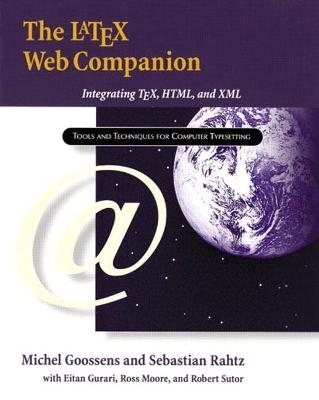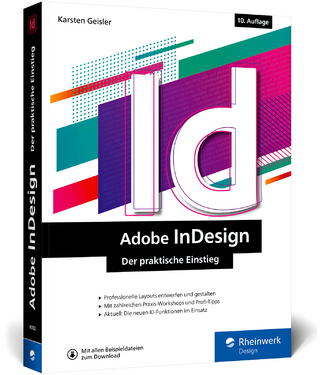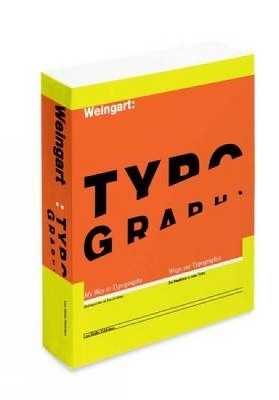
LaTeX Web Companion, The
Addison-Wesley Educational Publishers Inc (Verlag)
978-0-201-43311-1 (ISBN)
This book shows how you can publish LaTeX documents on the Web. LaTeX was born of the scientist's need to prepare well-formatted information, particularly with pictures and mathematics included; the Web was born of the scientist's need to communicate information electronically. Until now, it has been difficult to find solutions that address both needs. HTML and today's Web browsers deal inadequately with the nontextual components of scientific documents. This book, at last, describes tools and techniques for transforming LaTeX sources into Web formats for electronic publication, and for transforming Web sources into LaTeX documents for optimal printing.
You will learn how to: *Make full use of Acrobat with LaTeX *Convert existing documents to HTML or XML *Use mathematics in Web applications *Use LaTeX to prepare Web pages *Read and write simple XML/SGML *Produce high-quality printed pages from Web-hosted XML or HTML pages You will find practical descriptions of: *LaTeX2HTML, which uses Perl to interpret LaTeX source and generate HTML *TeX4ht, which redefines LaTeX's macros to generate HTML or XML *Browser plugins, such as techexplorer, that are able to interpret mathematical markup directly *Tools for authoring and interpreting XML *Tools for translating XML into various output formats, using Cascading Style Sheets, DSSSL, or XSL *Mathematical Markup Language (MathML) In addition to giving the Internet location of the software described in this book, the authors also provide a full, annotated catalogue of URLs for the standards and documentation relating to this fast-moving area. Many of the packages and programs described in this book are freely available in public software archives, and the source code for examples has been placed on CTAN, the TeX archives. 0201433117B04062001
Michel Goossens is past president of the TeX Users Group. A research physicist at CERN, where the Web paradigm was born, he is responsible for LaTeX, HTML, SGML, and, more recently, XML support for scientific documents. Sebastian Rahtz is Past Secretary of TUG, a cofounder of CTAN, creator of the TeX Live CD-ROM, and a co-author of The LaTeX Graphics Companion. He is an IT analyst at Elsevier Science Ltd. Eitan Gurari, Ross Moore, and Robert Sutor are, respectively, the principal architects of TeX4ht, LaTeX2HTML, and techexplorer. Eitan Gurari, Ross Moore, and Robert Sutor are, respectively, the principal architects of TeX4ht, LaTeX2HTML, and techexplorer. Eitan Gurari, Ross Moore, and Robert Sutor are, respectively, the principal architects of TeX4ht, LaTeX2HTML, and techexplorer. 0201433117AB11042003
List of Figures.
List of Tables.
Preface.
1. The Web, its documents, and LaTeX.
The Web, a window on the Internet.
The Hypertext Transport Protocol.
Universal Resource Locators and Identifiers.
The Hypertext Markup Language.
LaTeX in the Web environment.
Overview of document formats and strategies.
Staying with DVI.
PDF for typographic quality.
Down-translation to HTML.
Java and browser plug-ins.
Other LaTeX-related approaches to the Web.
Is there an optimal approach?
Conclusion.
2. Portable Document Format.
What is PDF?
Generating PDF from TeX.
Creating and manipulating PDF.
Setting up fonts.
Adding value to your PDF.
Rich PDF with LaTeX: The hyperref package.
Implicit behavior of hyperref.
Configuring hyperref.
Additional user macros for hyperlinks.
Acrobat-specific commands.
Special support for other packages.
Creating PDF and HTML forms.
Validating form fields.
Designing PDF documents for the screen.
Catalog of package options.
Generating PDF directly from TeX.
Setting up pdfTeX.
New primitives.
Graphics and color.
3. The LaTeX2HTML translator.
Introduction.
A few words on history.
Principles for Web document generation.
Required software and customization.
Running LaTeX2HTML on a LaTeX document.
Installation.
Customizing the local installation.
Extension mechanisms and LaTeX packages.
Mathematics modes with LaTeX2HTML.
An overview of LaTeX2HTML’s math modes.
Advanced mathematics with the math extension.
Unicode fonts and named entities, in expert mode.
HTML 4.0 and style sheets.
Large images and HTML 2.0.
Future use of MathML.
Support for different languages.
Titles and keywords.
Character-set encodings.
Multilingual documents using babel.
Images using special fonts.
Converting transliterations using preprocessors.
Extending LaTeX sources with hypertext commands using the html package.
Hyperlinks to external documents.
Enhancements appropriate for HTML.
Alternative text for hyperlinks.
Conditional environments.
Navigation and layout of HTML pages.
Example of linking various external documents.
Advanced features.
4. Translating LaTeX to HTML using TeX4ht.
Using TeX4ht.
Package options.
Picture representation of special content.
A complete example.
Manual creation of hypertext elements.
Raw hypertext code.
Hypertext pages.
Hypertext links.
Cascading Style Sheets.
How TeX4ht works.
From LaTeX to DVI.
From DVI to HTML.
Other matters.
Extended customization of TeX4ht.
Configuration files.
Tables of contents.
Parts, chapters, sections, and so on.
Defining sectioning commands.
Lists.
Environments.
Tables.
Small details.
The inner workings of TeX4ht.
The translation process.
Running LaTeX.
Running the tex4ht program.
A look at t4ht.
From DVI to GIF.
A taste of the lg file.
The font control files.
The control file.
5. Direct display of LaTeX on the Web.
IBM techexplorer Hypermedia Browser.
Basic formatting issues.
Your browser and techexplorer.
Adding hypertext links.
Popping up windows and footnotes.
Using images, sound, and video.
Defining and using pop-up menus.
Using color in your documents.
Building a document hierarchy.
Running applications.
Alternating between two displayed expressions.
Printing from techexplorer.
Searching in a document.
Optimizing your documents for techexplorer.
Scripting techexplorer from Java and JavaScript.
WebEQ.
An introduction to WebTeX.
Adding interactivity.
Using the APPLET tag with WebEQ.
Preparing HTML pages via the WebEQ Wizard.
Embedded content problems and future developments.
Expression size.
Ambient style.
6. HTML, SGML, and XML: Three markup languages.
Will HTML lead to the downfall of the Web?
HTML 4: A richer and more coherent language.
HTML 4 goodies.
HTML 4, the end of the old road.
Why SGML?
Different types of markup.
Generalized logical markup.
SGML to HTML and XML.
Extensible Markup Languages.
What is XML?
The components of XML.
Declaring document elements.
The detailed structure of an XML document.
XML is truly international.
XML document components.
The XML declaration.
The document type declaration.
Document elements.
XML parsers and tools.
Emacs and psgml.
The perlSGML programs.
The DTDParse tool.
The Language Technology Group XML toolbox.
Validating documents with XML parsers.
7. CSS, DSSSL, and XSL: Doing it with style.
Style sheet languages: A short history.
Programming or style sheets, which is better?
Formatting with Perl.
Principles of operation.
Generating a LaTeX instance.
Cascading Style Sheets.
The basic structure of a Cascading Style Sheet.
Associating style sheets with a document.
A quick look at Cascading Style Sheet properties.
Cascading Style Sheets for formatting XML documents.
The invitation example revisited.
Generating HTML with another document instance.
Document Style Semantics and Specification Language.
The components of DSSSL.
Creating style sheets with DSSSL.
Introducing Jade.
The TeX backend for Jade and the JadeTeX macros.
The Jade SGML transformation interface.
Formatting real-life documents with DSSSL.
Extensible Style Language.
The general structure of an XSL style sheet.
Building the source tree.
Template rules.
XSL processors.
Patterns.
Templates.
Formatting objects and their properties.
Proposed extensibility mechanism.
Using XSL to generate HTML or LaTeX.
Using XSL to generate formatting objects.
Summary.
8. MathML, intelligent math markup.
Introduction to MathML.
MathML, Unicode, and XML entities.
MathML software.
Equation editors.
Web browser support for MathML.
Converting LaTeX to MathML.
Typesetting MathML.
Appendix A: Example files.
An example LaTeX file and its translation to XML.
The LaTeX source.
LaTeX converted to XML.
Document Type Definition for XML version.
techexplorer scripting examples.
teched.html.
teched.java.
Appendix B: Technical appendixes.
The HyperTeX standard.
Configuring TeX4ht to produce XML.
Starting from scratch.
Adding XML tags.
Getting deeper for extra configurations.
XML name spaces.
Examples of important DTDs.
The DocBook DTD.
The AAP effort and ISO 12083.
Text Encoding Initiative.
A DTD for BIBTeX.
LaTeX -like markup, from DTD to printed document.
Transforming HTML into XML.
HTML in XML.
The Extensible HyperText Markup Language.
Java event-based interface.
The SAX Java classes.
Running a SAX application.
Appendix C: Internationalization issues.
Codes for languages, countries, and scripts.
The Unicode standard.
Character codes and glyphs.
Unicode and ISO/IEC 10646-1.
UTF-8 and UTF-16 encodings.
Foreign languages in XML.
Latin-based encodings.
Handling non-Latin encodings with UTF8.
Glossary.
URL catalog.
Bibliography.
Index. 0201433117T04062001
| Erscheint lt. Verlag | 23.7.1999 |
|---|---|
| Reihe/Serie | Addison-Wesley Series on Tools and Techniques for Computer Typesetting |
| Verlagsort | New Jersey |
| Sprache | englisch |
| Maße | 189 x 235 mm |
| Gewicht | 830 g |
| Themenwelt | Informatik ► Grafik / Design ► Desktop Publishing / Typographie |
| Mathematik / Informatik ► Informatik ► Web / Internet | |
| Informatik ► Weitere Themen ► LaTeX | |
| ISBN-10 | 0-201-43311-7 / 0201433117 |
| ISBN-13 | 978-0-201-43311-1 / 9780201433111 |
| Zustand | Neuware |
| Informationen gemäß Produktsicherheitsverordnung (GPSR) | |
| Haben Sie eine Frage zum Produkt? |
aus dem Bereich


